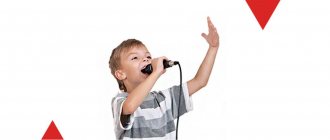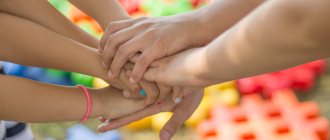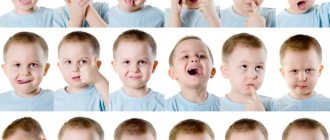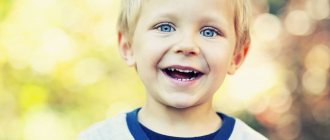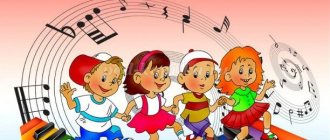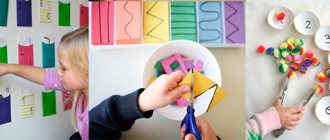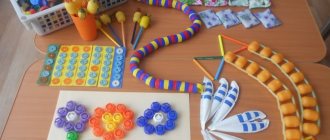Numerous studies indicate that musical exercise has a positive effect on children's intellectual development, as well as their ability to interact with others.
The most popular musical technique for preschool children in Russia is the development of Sergei and Ekaterina Zheleznov. Both methodologists have musical and pedagogical education. Extensive teaching experience allowed Sergei and Ekaterina to create comprehensive programs that are distinguished by an accessible game form and systematic approach.
The technique includes gesture, finger and movement games, staged fairy tales that the child performs to music, songs, nursery rhymes, and lullabies.
What is this
Volkova G.A., Shashkina G.R., Ekaterina Zheleznova studied the positive impact of rhythmic movements on speech together with the pronunciation of words and correct breathing in Russia. From their point of view, logorhythmics is a complex system of motor exercises aimed at eliminating speech anomalies in preschoolers and developing motor skills.
V.A. Gilyarovsky and N.A. Vlasova defined what logorhythmics is differently. In the mid-20th century, they studied the causes and methods of correcting logoneuroses. The main attention was paid to the word as a way to solve speech disorders. Rhythm and movement were given a secondary role. But they noted the usefulness of speech therapy rhythms for intellectual and aesthetic development.
In other words, logorhythmics is an activity that includes marching to rhythmic music, walking to a count, and running. Simultaneously with physical activity, the task is to control breathing, pronounce phrases, sing in a certain intonation, loudly or quietly, etc. Classes are held in an entertaining format, in a group or individually.
The benefits of the technique
Thanks to it, correct speech is produced, because classes include elements of imitation of different sounds.
For example, those made by different animals. Or repeated repetition of different words, memorization of simple but useful rhymes for training the speech apparatus.
The child develops motor skills because he has to use different objects in the exercises.
He receives many tactile and auditory sensations - the development of sensory organs occurs simultaneously and comprehensively.
During the exercises, the child learns to act in a team and establishes communication with other children. If we are talking about a home environment, then he can maintain close contact with his mother.
This technique is well suited if children have neurological disorders. Music calms and relaxes, puts the child in a calm, positive mood.
Zheleznov's methods
Zheleznova’s finger exercises are one of the ways to conduct finger gymnastics and develop fine motor skills in a playful way. These games are ideal for children from two to five years old. All games are accompanied by funny songs and rhymes.
Playing finger games by Ekaterina Zheleznova, children receive various sensory impressions, learn to focus on any specific activity, and train attentiveness. The heroes of such games - rain and sun, butterfly and spider, goat and hare - delight 1.5-2 year old children. These characters help teach children to count and understand the meaning of the words “above”, “below”, “right”, “left”, “above”, “below”. How much the little one will like the game depends on how it is presented to adults. For the little ones, calmness, affection, care and caution in touch are of great importance.
For three to five year old children, the speech and expressiveness of an adult’s facial expressions are important, therefore, in order to recite a poem expressively, you will need to learn it by heart.
Advice The movements made by the right and left hands are controlled by different hemispheres of the brain. Therefore, first teach your child to perform the exercise with one hand, then with the other, and only after that with both at the same time.
Games where you need to act with your fingers in turns, for example, “2 red cockroaches” or “2 plump piglets,” can only be handled independently by children who are already four or five years old. A child under this age performs exercises only with the help of an adult.
Disadvantages of the method
Dancing, games and funny songs will put any child in a positive mood. But if you take a closer look, you can identify some points that are rather small nuances than shortcomings. The child is asked to strictly follow the proposed action plan. The right to choose and independently invent movements is not given. There are many complex repetitions and rhymes that little children do not immediately begin to learn. Ekaterina Zheleznova, whose methodology is used in many development centers, together with her father, composed many original songs, but mostly they are of the same type. The same words are often repeated, for example: bunny or bear and their actions, sleep, take a walk. Although for very young children it is precisely this repetition of the same type of words that is preferable.
Any parent, even without a musical education or understanding of musical literacy, can, based on this technique, comprehensively develop their child and instill in him a good taste in music.
Goals and objectives
The main goal of speech therapy rhythm for preschoolers is the correction and prevention of speech disorders by improving motor skills. Logorhythmics also has other related goals - health improvement, physical and spiritual education.
A lesson with elements of logorhythmics poses the following tasks for the teacher:
- Breathing development
- Correction of speech disorders
- Training in control of movements, speech, functioning of the organs of articulation and breathing
- Improving coordination
- Development of all types of memory, attention, spatial orientation
- Cultivating a sense of rhythm
- Reinforcing spatial concepts
- Introduction to spiritual values (music)
- Learning to sing and pronounce tongue twisters
- Expanding your horizons
- Increasing vocabulary
What is logorhythmics
Logorhythmics by Zheleznova for children 2-3 years old is a whole complex of therapeutic exercises with the addition of neurogymnastics . During logorhythmics classes, children perform certain speech tasks using special movements, words and music.
The main goal of logorhythmics is to do everything possible to help every child with speech problems learn to speak correctly and clearly and develop an ear for music.
Zheleznova’s logorhythmics for children 2-3 years old is a correction method actively used by Russian specialists, during which various types of games and training are actively used.
Including such as:
- walking with a change of direction;
- breathing development tasks;
- exercises to improve muscle tone;
- articulation of poetry;
- singing.
Complexes for children 2-3 years old
Logorhythmics for kids involves the creation of special sets of exercises and entertaining activities. Games and exercises are performed using the method of imitation.
Animals
- Helps to get acquainted with the world of animals, insects, birds. Classes involve reading poetry, imitating walking movements, and animal sounds.
- Kids can walk like a bear, flap their wings like a swan, a sparrow, walk like a duck, etc.
- Onomatopoeia is required. The teacher asks: “How does a goose scream when it flies?” Pupils should wave their arms and answer: “HA-HA!”
- Pictures of animals and birds are used to help the speech therapist, teacher and parents.
- You can use the story with the bear and the cone:
The clumsy bear walks through the forest, collects cones and puts them in his pocket...
Children walk with their teacher, roar like a bear, and collect pine cones.
Vegetables and fruits
- They expand their knowledge of the world around them, the colors of fruits, and introduce them to their names.
- The following exercises are used for the lesson:
Salt the cabbage. The poem is read:
We cut the cabbage, cut it, We chop the cabbage, chop it...
Children make movements with their hands, pretending to be a knife or a hatchet.
We salt the cabbage, salt it, We press the cabbage, press it.
And we'll grate the carrots.
They depict how they stir, salt, and squeeze chopped vegetables.
- Let's go to the garden
Pictures depicting garden vegetables and garden fruits are used. First, you should have a conversation, tell preschoolers about where vegetables and fruits grow, what color they are, how they smell, etc.
Then a scene of a trip to the garden to collect the harvest is depicted. You can use fruit toys that the children will pick from trees and collect from beds. A competition game is suitable: children are divided into 2 teams, toy fruits are laid out around the room. The teacher asks each team to find as many fruits from one group as possible: for example, vegetables. Children take turns looking for them and bringing them to their basket.
Methodology of Ekaterina Zheleznova
The author's logorhythmics training program includes musical, speech, and physical exercises at the same time. The baby dances, imitates sounds, sings.
To play the game you need manuals, backing tracks with recordings of musical accompaniment. Zheleznova’s logorhythmics is used for the development of speech and phonemic hearing in children 3-4 years old and older.
When can I start?
The Zheleznov development method is designed for children from 6 months to 7 years. As a rule, babies are offered comfortable pillows on which they can wave their arms and legs to the beat of the music. Older children are already walking around the entire perimeter of the room. But even if the baby is still very small, the mother can always start playing with him. All games fit perfectly into a child’s daily life. Here the mother carries the child to wash and hums: “Water, water, wash my face...” Or, bending and unbending the baby’s legs, she says: “Bear-toed bear...” All this is the initial stage of introducing the child to a sense of rhythm and musicality.
How to practice
Recommendations for playing games:
- Pronounce the poems as expressively as possible, lowering and raising your voice while simultaneously performing the movements.
- It will be good to sing poetry to some melody.
- Do all the exercises with your baby, this will give you the opportunity to create the necessary mood, help the baby remember the movements and do them correctly.
- After several lessons, children usually begin to repeat parts of phrases after adults, and a little later - the entire poem, while correlating the movements with the spoken words.
- Don't be too demanding about your exercises. It won’t be easy for your child to recite a poem while doing the exercise at the same time. It is very important not to initially discourage your child from studying.
- Start with two or three games, gradually adding new ones. Over time, the baby will develop favorite exercises that he will be happy to return to many times.
- Under no circumstances force your child to play; try to find out the reason for the refusal and, if possible, eliminate it.
- Try not to focus on your child’s mistakes when doing exercises. But be sure to praise your child for the slightest success, this will push him to more significant achievements.
All finger games by Katya Zheleznova are carried out in three ways:
- the adult performs the movements, and the child observes;
- the adult makes movements with the baby’s hands;
- The baby makes movements with his own hands.
Complex for children 3-4 years old
Logorhythmics in kindergarten for children over 3 years old may include the following complexes:
- Finger gymnastics
You need to stretch the fingers of both hands, make locks, depict boats, household items, etc. At the same time, poems are recited on various topics:
- Who sings what?
The cat sings a song: Meow! Meow! (children petting an imaginary cat).
The clock sings: Tick! So! (the handles represent ticking arrows).
Piglet grunts: Oink! Oink! (fingers make a patch - a circle).
The cabin in the river does not sing: Mmmmm! Mmmm! (press their lips, cover their mouth with their hands), etc.
- Mushrooms
Children stand in a row and walk through the forest to look for mushrooms. Massage your fingers without ceasing to walk. The teacher counts, creating a rhythm.
Top-top - five steps (children step to the rhythm of the poem), And in the basket there are five mushrooms (we count the fingers on the hands), Amanita is red (we stretch the index finger), It is very dangerous. And the second is a fox (we touch the next finger), a red pigtail. Pink ear (touch the ears) The third mushroom is the trumpet mushroom. And the fourth mushroom is the morel (tugging at the ring finger), a bearded old man. Well, what is the fifth mushroom? White! (put your hands in a lock and play with your fingers).
- Singing
Music lessons are used. Children learn breathing exercises. It is not necessary to sing songs; you can hum individual sounds, imitate animals, while doing physical exercises at the same time.
- Outdoor games to music
Logorhythmic exercises are performed with musical accompaniment. Words and movements are learned, attention and memory develop. You can use balls, passing them around to each other in a circle, chairs, toys to hide and quickly find, etc. Logorhythmics tasks for children 3-4 years old can be slightly complicated and used for games with the older, preparatory group.
About the authors
Sergey Stanislavovich and Ekaterina Sergeevna Zheleznov (father and daughter) developed their own method for the early development of children.
Sergey Stanislavovich Zheleznov is an experienced teacher (pianist and composer) of children's music schools in Moscow, who organized the early development studio “Music with Mom”.
Ekaterina Sergeevna Zheleznova is a follower of her father, graduated from a music pedagogical college and a Graduate School of Advanced Studies, and is now a teacher and methodologist - the head of her father’s original school.
Initially, this program was a preparatory course for children aged 4-6 years to enter music schools, where they learned notes, first songs and played musical instruments.
Later, the technique began to expand its position and it was decided to deepen it. In the mid-90s, there was practically no musical material to engage children under 3 years old.
Then the Zheleznovs began to independently write small songs that kids could understand, songs with movements, and refine Russian nursery rhymes. This is how new collections were born.
The program is designed for different ages. It can also be used for very small toddlers from six months of age, when they can dance in their mother’s arms. Of course, here they are only listeners.
And at the age of about a year they can already dance. Then, older ones can perform songs with movements, first with adults, then on their own.
Complex for children 5-6 years old
- Movement exercises It is better if the children themselves come up with movements to the poem that the teacher reads:
We will go to the forest today (children are walking), Who climbed the tree? (raise their heads up) Cuckoo? Cuckoo? (put hands to lips, repeat words) I’ll find you anyway
- Physical warm-up
Physical education to music. The poetic form of commands is used. Children gradually learn it by heart and pronounce it themselves.
The mouse ran quickly (we move one after another, slowly), The mouse wagged its tail (we repeat the movements of the animal), And dropped the egg (tilt down - lift up), Look, oh, it broke (we shake our heads, put our palms to our cheeks).
Logorhythmics in preschool educational institutions is used in any lesson: physical education, speech therapy, music. Teachers should pay attention to the pronunciation of auxiliary poems and words by children, and to the correct breathing of children during exercise.
Recommendations for conducting classes
- Shape the lesson load according to the age and development level of preschoolers
- Give a lesson in the afternoon
- Change the topic of the lesson every week
- When selecting material, rely on lexical topics
- Use fairy tales and cartoons for speech and music exercises
- Exercise every day
- Accurately and clearly demonstrate to children the movements of their hands, body, and lips during phonation. Monitor the quality of assignments.
Sources
- https://orechi.ru/razvitie-rechi/logoritmika
- https://Razvivashka.online/metodiki/palchikovaya-gimnastika-zheleznovoy
[collapse]
Classes
Zheleznova’s logorhythmics were specially developed for children 2-3 years old. It is presented in a playful way, which will help the child in the company of other peers to significantly accelerate the acquisition of speech skills.
More often, a kindergarten takes on the function of teaching children logarithmics, but parents should also get involved in the training in order to consolidate the achieved results at home. Special exercises and games carried out at home will not take much time and will bring positivity to the family.
Zheleznova’s logorhythmics helps achieve the following goals:
- correct and train speech skills;
- carry out a complete recovery of the child’s body;
- develop proper breathing;
- improve coordination;
- improve aesthetic education;
- improve your sense of rhythm.
Zheleznova’s logorhythmics for children 2-3 years old involves the use of music, which allows further development of phonetic hearing. Simple and understandable songs about a bus, a bear, a spider, are composed in such a way as to maximally work out each muscle responsible for articulation.
A classic lesson using the Zheleznova method should consist of the following steps:
- greetings;
- warm-up;
- games involving gestures and finger exercises;
- massage in the form of a game;
- gymnastics to music;
- logorhythmics;
- chanting and singing;
- fairy tales;
- parting.
On average, one lesson should last no more than 45 minutes, otherwise the child will get tired and will not complete the entire program.
Bus
This exercise must be performed on a ball.
Speech therapist says:
- Here we are sitting on the bus, and sitting, and sitting.
At this time, the children slowly sway from side to side on the ball.
- And we look out of the window, we all look!
Children raise their hands and close their fingers in the shape of a window, then look out of it, turning first one way or the other.
- We look back, we look forward, like this, like this.
Children make turns in one direction or the other, peering into the distance from under their palms.
- Well, the bus is not lucky, is it not lucky?
A shrug is performed.
- The wheels started spinning like this, like this, we rolled forward like this!
At this time, children perform circular movements with their arms in front of them.
- And the brushes rustle on the glass, whack-whack-whack, whack-whack-whack,
- All the droplets want to sweep away whack-whack-whack!
Swinging is performed with arms bent at the elbows, which imitate the work of windshield wipers.
- And it’s not just that we sit, turn the steering wheel and beep: beep-beep-beep, beep-beep-beep,
- We all hum loudly and loudly: beep-beep-beep!
- Let the bus shake us like this, like this,
- We are moving and moving forward just like that!
Everyone is actively jumping on balls.
Beanbag
- Rattle, rattle, musical toy.
- If you want, take two at once and rattle, rattle, rattle,
- If you want, take two at once and rattle, rattle, rattle.
- Hide the rattle behind your back, your ears will rest from the noise,
- Look at your neighbor and sit quietly,
- Look at your neighbor and sit quietly.
Watch
Speech therapist says:
We sit on a rug or pillow (on our knees). We move our fingers (“run”) from the knees to the top of the head.
- The mouse climbed for the first time
- See what time it is.
- Suddenly the clock said: “Bang!”
Children perform one clap above their heads.
- The mouse rolled head over heels.
Children put their hands on the floor.
- The mouse climbed in a second time
- See what time it is
- Suddenly the clock said: “Bom, bom!”
Children perform 2 claps.
- The mouse rolled head over heels.
- The mouse climbed for the third time
- See what time it is.
- Suddenly the clock said: “Bom, bom, bom!”
Children perform 3 claps.
- The mouse rolled head over heels.
Little frogs
- Four frogs are sitting together on a stump,
- They sit on a stump together and eat delicious worms:
- Yum-yum, yum-yum, yum-yum-yum-yum-yum-yum!
- Yum-yum, yum-yum, yum-yum-yum-yum-yum-yum!
- Suddenly one dived into a puddle, fell asleep in the warm water,
- And three frogs eat delicious worms:
- Om-Nom-nom…
- Suddenly one dived into a puddle, fell asleep in the warm water,
- And two frogs eat delicious worms:
- Om-Nom-nom…
- Suddenly he dived into a puddle and fell asleep in the warm water.
- The latter still sits and looks at the worms.
Warm-up
When pronouncing the words of the song, the child must repeat the movements indicated in it:
- We nod our heads,
- Let's shake our noses,
- And let's knock our teeth
- And let's be silent for a while.
- We'll roll our shoulders
- And let's not forget about the pens,
- Let's shake our fingers
- And let's rest a little.
- We'll kick our feet
- And let's squat a little
- Let's match a leg with a leg
- And let's start all over again...
Our pens
Speech therapist says:
- Our hands are dirty, let's wash them with warm water.
- We wash our hands like this, like this.
Children imitate hand washing.
The speech therapist continues:
- We raise our hands, like this, like this.
- We raise our hands up, fingers spread out, and turn the “lanterns” over.
- We lower our arms like this, like this.
- We lower our hands, fingers spread, and turn the “lanterns” over.
- And we put it behind our back like this, like this.
Children put their hands behind their backs.
I want to build a house
- I want to build a house
- So that there is a window in it,
- So that the house has a door,
- Nearby for a pine tree to grow.
- So that there is a fence around
- The dog guarded the gate,
- So that a bug lives on the grass,
- He ran fast p-u-check.
- I want to build a house
- So that there is a window in it,
- So that the house has a door,
- Nearby for a pine tree to grow.
- It was sunny, it was raining,
- So that the tulip blooms in the garden,
- So that there is a flag on the house,
- And behind the house there lived a hedgehog.
Bunny
- The bunny jumped, jumped, jumped, jumped and got tired.
Children are jumping.
- He wiggled his tail.
Children drive the body.
- He raised his ears up.
Lesson on logorhythmics (Zheleznova system for children 2-3 years old).
Exercise - “Bunny” Children use their hands to depict bunny ears above their heads.
- The bunny jumped, jumped, jumped, jumped and got tired.
Children are jumping.
- He wiggled his tail.
Children drive the body.
- He raised his ears up.
Children use their hands to depict bunny ears above their heads.
- And the bunny heard a quiet, very quiet sound.
Children put their hand to their right ear and turn to the right, as well as to the left.
- I looked around.
Children make a “visor” over their eyes with their hands, turn to the right and also to the left.
- He suddenly jumped into the hole.
Children bounce in place or jump forward.
In giraffes
Before the game, the speech therapist asks the child to talk about what a giraffe, elephant, zebra, and cat look like.
You need to show them pictures of these animals, noting their characteristic external features:
- the giraffe has spots;
- the elephant has folds;
- the kitten has fur;
- The zebra has stripes.
Next, the speech therapist reinforces the words with gestures that will be used in the game:
- Giraffes have spots, we clap our hands all over the body.
- Elephants have folds, we “collect the folds”, we pinch ourselves.
- Kittens have fur, let's stroke ourselves.
- And the zebra has stripes, we run our fingers or the edge of our palm along the body.
During the chorus, children point with their index fingers at the named body parts.
Together with us
- You clap with us: clap and clap.
- You clap with us: clap and clap.
- You clap with us, you clap with us.
- You clap with us: clap and clap.
- You stomp along with us: stomp and stomp...
- You jump with us: jump and jump...
- And now you will dance with us,
- And now you will dance with us,
- And now you will be with us, and now you will be with us,
- And now you will dance with us.
To get real, lasting and quick results, you should follow several important rules:
| Rules | Peculiarities |
| Correct load formation | Select the load for the child according to his age. |
| Choose the right class time | The best time for classes is in the afternoon, after the child has had lunch and rested. |
| Change the topic of the lesson | Try to select different topics for classes every week, then it will be more interesting for the child. |
| Correctly selected material | When selecting, it is important to focus on lexical topics. |
| Diversify the material | Try to organize the lesson correctly, add scenes from fairy tales or cartoons to make it more interesting for the child to perform speech and musical exercises. |
| Regularity | You need to work with your child every day. |
| Show movements correctly | Try to show all the movements correctly, pronounce the words of the songs so that the child understands everything. |
Logorhythmics by Zheleznova is a unique author’s program that includes musical, speech and physical exercises. Children aged 2-3 years enjoy dancing, singing and imitating different sounds, improving their speech, improving motor function and becoming completely healthy.
It is very important to remember that results can only be achieved if logarithmics are performed regularly.

